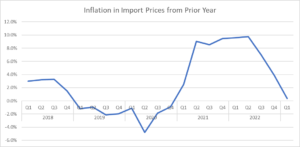Article • Dean Baker’s Beat the Press
Fact-based, data-driven research and analysis to advance democratic debate on vital issues shaping people’s lives.
Center for Economic and Policy Research
1611 Connecticut Ave. NW
Suite 400
Washington, DC 20009
Tel: 202-293-5380
Fax: 202-588-1356
https://cepr.net
Maybe I’ve missed it, but I have seen very little mention of import prices in discussions of the current and future course of inflation. That seems a bit odd, both because the volume of imports is large relative to the economy and there seems to be quite a story here.
On the first point, imports are currently running at a bit less than 15.0 percent of GDP. That is a big deal if we think of imports as inputs into final products, like the imported steel in the cars that we manufacture here.
However, it is probably an even bigger deal in the context of competition with domestic products. While the relationship is not one to one, if the price of competing imports of clothes, appliances, or other items rises by 5.0 percent, then we can assume that U.S. producers will look to raise their prices by a comparable amount. The same story applies to falling prices.
This gets us to the interesting story. We all know about the big jump in inflation as the economy reopened following the pandemic. We saw a comparable picture with import prices.

Source: Bureau of Economic Analysis and author’s calculations.
As can be seen, year over year inflation in import prices originally fell at the start of the pandemic, going from an annual rate of around -1.0 percent to -4.8 percent in the second quarter of 2020, when the economy was largely shut down. Then import prices turned around and began to rise rapidly. The year over year rate of inflation was close to or above 9.0 percent every quarter from the second quarter of 2021 to the second quarter of 2022.
However, the quarterly change in import prices turned negative in the third quarter of last year. The year over year rate of inflation for the first quarter of 2023 was just 0.4 percent, and it is likely to be negative in the current quarter.
This doesn’t guarantee the soft landing that many of us are hoping for, but it is a big factor pushing in the right direction. Over a long period, we can expect the rate of inflation to be roughly equal to the rate of hourly wage growth, minus the rate of productivity growth. But insofar as rate of increase in import prices is less than this rate, it will pull down the rate of domestic inflation somewhat.
And, with imports close to 15 percent of GDP, the impact is large enough to matter. Just to show the simple arithmetic, if import prices rise 2.0 percentage points less than the inflation rate implied by the wages minus productivity calculation, that would knock 0.3 percentage points off the inflation rate.
The real world is of course more complicated than this arithmetic implies. Nonetheless, imports are a big enough factor in the economy that the rate of inflation in import prices will affect our domestic inflation rate. And, in 2021 and the first half of 2022, they were a big factor fueling domestic inflation. They are now a factor restraining domestic inflation.